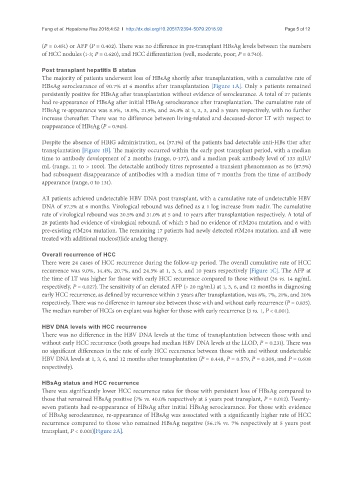Page 692 - Read Online
P. 692
Fung et al. Hepatoma Res 2018;4:62 I http://dx.doi.org/10.20517/2394-5079.2018.92 Page 5 of 12
(P = 0.451) or AFP (P = 0.402). There was no difference in pre-transplant HBsAg levels between the numbers
of HCC nodules (1-3; P = 0.620), and HCC differentiation (well, moderate, poor; P = 0.740).
Post transplant hepatitis B status
The majority of patients underwent loss of HBsAg shortly after transplantation, with a cumulative rate of
HBsAg seroclearance of 90.7% at 6 months after transplantation [Figure 1A]. Only 5 patients remained
persistently positive for HBsAg after transplantation without evidence of seroclearance. A total of 27 patients
had re-appearance of HBsAg after initial HBsAg seroclearance after transplantation. The cumulative rate of
HBsAg re-appearance was 8.5%, 18.0%, 21.9%, and 26.4% at 1, 2, 3, and 5 years respectively, with no further
increase thereafter. There was no difference between living-related and deceased-donor LT with respect to
reappearance of HBsAg (P = 0.945).
Despite the absence of HBIG administration, 64 (57.1%) of the patients had detectable anti-HBs titer after
transplantation [Figure 1B]. The majority occurred within the early post transplant period, with a median
time to antibody development of 2 months (range, 0-137), and a median peak antibody level of 133 mIU/
mL (range, 11 to > 1000). The detectable antibody titres represented a transient phenomenon as 56 (87.5%)
had subsequent disappearance of antibodies with a median time of 7 months from the time of antibody
appearance (range, 0 to 131).
All patients achieved undetectable HBV DNA post transplant, with a cumulative rate of undetectable HBV
DNA of 97.3% at 6 months. Virological rebound was defined as a 1 log increase from nadir. The cumulative
rate of virological rebound was 20.5% and 31.0% at 5 and 10 years after transplantation respectively. A total of
28 patients had evidence of virological rebound, of which 5 had no evidence of rtM204 mutation, and 6 with
pre-existing rtM204 mutation. The remaining 17 patients had newly detected rtM204 mutation, and all were
treated with additional nucleos(t)ide analog therapy.
Overall recurrence of HCC
There were 24 cases of HCC recurrence during the follow-up period. The overall cumulative rate of HCC
recurrence was 9.0%, 14.4%, 20.7%, and 24.3% at 1, 3, 5, and 10 years respectively [Figure 1C]. The AFP at
the time of LT was higher for those with early HCC recurrence compared to those without (38 vs. 14 ng/mL
respectively, P = 0.027). The sensitivity of an elevated AFP (> 20 ng/mL) at 1, 3, 6, and 12 months in diagnosing
early HCC recurrence, as defined by recurrence within 3 years after transplantation, was 8%, 7%, 21%, and 20%
respectively. There was no difference in tumour size between those with and without early recurrence (P = 0.835).
The median number of HCCs on explant was higher for those with early recurrence (3 vs. 1, P < 0.001).
HBV DNA levels with HCC recurrence
There was no difference in the HBV DNA levels at the time of transplantation between those with and
without early HCC recurrence (both groups had median HBV DNA levels at the LLOD, P = 0.231). There was
no significant differences in the rate of early HCC recurrence between those with and without undetectable
HBV DNA levels at 1, 3, 6, and 12 months after transplantation (P = 0.448, P = 0.579, P = 0.308, and P = 0.608
respectively).
HBsAg status and HCC recurrence
There was significantly lower HCC recurrence rates for those with persistent loss of HBsAg compared to
those that remained HBsAg positive (7% vs. 40.0% respectively at 5 years post transplant, P = 0.012). Twenty-
seven patients had re-appearance of HBsAg after initial HBsAg seroclearance. For those with evidence
of HBsAg seroclearance, re-appearance of HBsAg was associated with a significantly higher rate of HCC
recurrence compared to those who remained HBsAg negative (56.1% vs. 7% respectively at 5 years post
transplant, P < 0.001)[Figure 2A].

